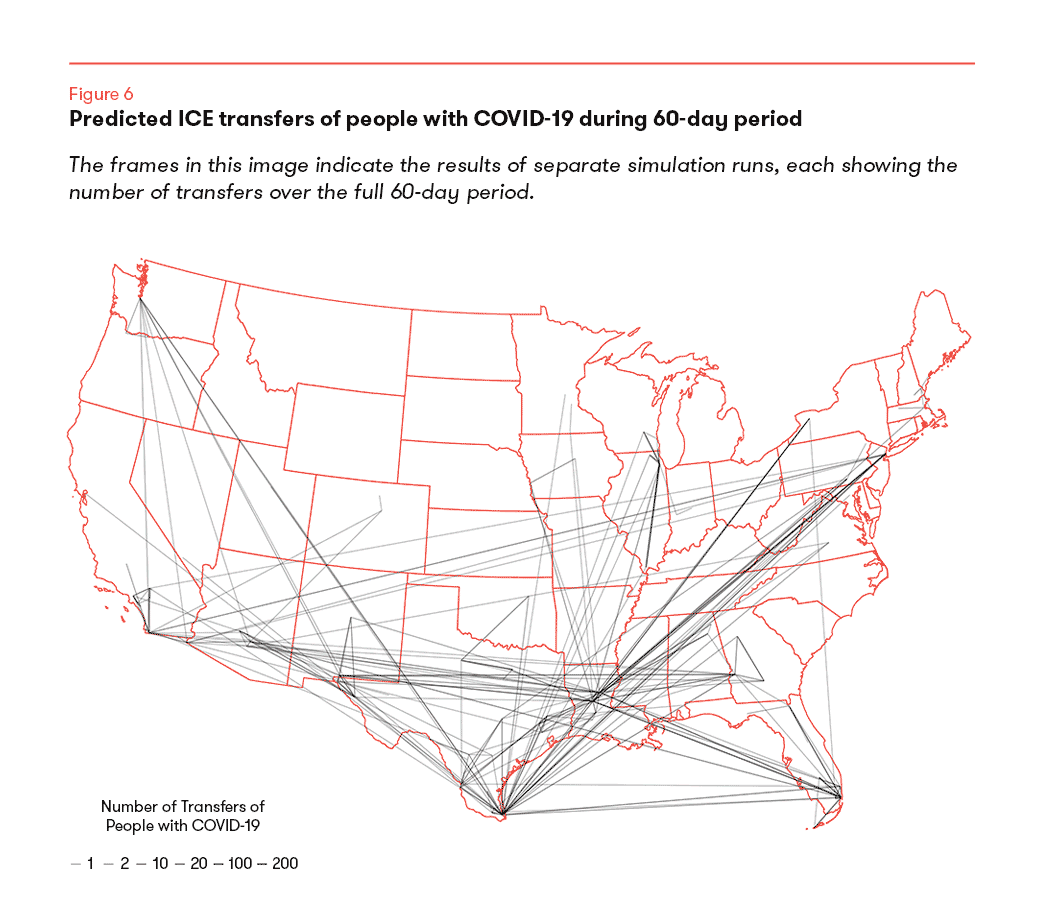Overview
Little is publicly known about the prevalence of COVID-19 in immigration detention facilities run by Immigration and Customs Enforcement (ICE). Conditions of confinement put people at high risk for contracting the virus, but ICE has shared little information with the public about what it may be doing to mitigate its spread.[]See Vera Institute of Justice, “Coronavirus Guidance for the Criminal and Immigration Legal Systems,” March 2020, https://perma.cc/2BQ8-R9NP.
As of May 31, 2020, ICE reported having tested 2,781 people in its custody, with 1,461 positive cases at just 60 of the more than 200 facilities it uses to detain adults and families.[]Vera routinely archives data from ICE’s COVID-19 Guidance webpage, which ICE replaces with updated numbers on a near-daily basis (with the exception of weekends). Across these archived snapshots, ICE reported a total of 98 distinct names of facilities at which people have tested positive for COVID-19 between March 24, 2020, and June 24, 2020. Vera researchers classified these 98 facility names as 64 known detention centers and one local hospital. At the time of this report, 63 facilities were listed with present or former COVID-19 cases; one facility, “LA Staging,” was included on the page on June 1 and 2 but has since been excluded from reporting. ICE is not responsible for the custody of unaccompanied children. The Office of Refugee Resettlement has not published information on COVID-19 cases among children in its custody. ICE has not clarified whether the remaining tests are confirmed negative or still pending, which means that a minimum of 52 percent of people tested through May 31 had contracted COVID-19. More recently, ICE’s updated statistics as of June 24 show 2,489 positives among 8,858 people tested, suggesting a minimum of 28 percent through June 24.[]The number of confirmed cases did not increase proportionally to keep pace with the number of increased tests. This may indicate that ICE is reporting pending tests in its total count. Figure 1 shows the cumulative number of tests and positive cases among detained people as reported by ICE through June 24, 2020. At the time of this report’s publication, two people have died in ICE custody as a result of COVID-19, and a third person reportedly died of COVID-19 shortly after release from detention.

The basic statistics ICE has shared obscure information, such as the total number of people ICE has detained at any point since the first publicly-reported case of COVID-19. The ICE COVID-19 webpage reports only on the number of currently detained people (23,429 as of June 24, 2020). However, calculations conducted by the Vera Institute of Justice (Vera) using ICE’s own detention statistics show that, at the time of writing, more than 66,000 people have been detained or newly booked into detention at any point since ICE’s first reported case of COVID-19. Similarly, ICE has changed the way it reports on positive cases to distinguish between “confirmed cases currently under isolation or monitoring”—the number it lists at the top of its COVID-19 page—and total confirmed cases since it started testing. Its method of reporting makes it impossible to answer basic questions of critical public interest such as how many currently detained people have been tested nationally and per facility, how many people have been released to hospitals or the community, or how many people with positive cases have been deported. Reports from around the country and ICE’s own testimony to Congress make it apparent that ICE continues to move people between facilities without testing people who appear asymptomatic, despite U.S. Centers for Disease Control and Prevention (CDC) recommendations that ICE restrict transfers.[]In a federal court hearing on May 27, an attorney representing ICE stated that ICE was not testing people who were asymptomatic and that ICE is not able to test people prior to transferring them to other facilities, noting "...ideally if we had the capacity to do so, we would test everybody before transfers were done to make sure that they were not infected, but that capacity does not exist." See Monique O. Madan, “ICE Admits to Transferring Detainees with COVID-19, Says It Can’t Test Everybody,” Miami Herald, May 27, 2020, https://www.miamiherald.com/news/local/immigration/article243031176.html; The U.S. Centers for Disease Control and Prevention (CDC), Interim Guidance on Management of Coronavirus Disease 2019 (COVID-19) in Correctional and Detention Facilities, (Atlanta, Georgia: CDC, March 2020), https://perma.cc/SG5C-WQL8.
To demonstrate the possible prevalence of COVID-19 in detention, researchers at Vera’s Center on Immigration and Justice built an epidemiological model, based on methodologies developed by teams modeling the spread of COVID-19 in other congregate settings (see “The methodology behind Vera’s model,” below). Using the most recent publicly available ICE data, the model specifically explores how new book-ins to—and frequent transfers between—detention centers may be contributing to COVID-19’s spread among people in immigration detention. Through simulating a 60-day period beginning in mid-March 2020, Vera’s model estimated that nearly one in five people detained for any length of time during this period would be infected with COVID-19.
Vera believes it is important to share these initial estimates as the researchers continue to refine the model to help shine a light on what could be happening to people inside detention centers. Vera’s estimates make clear that there is no scenario in which the data ICE has reported to the public reflects the true scope of the spread of COVID-19 in detention and that the actual number of positive cases may be up to 15 times higher than the figures reported by ICE as of mid-May.








